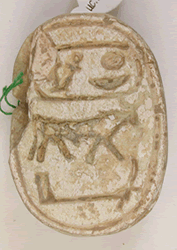Amenhotep III (about
1388-1351/50 BC)
With a reign of some 39 years Amenhotep III is one of the most
important kings of the Eighteenth Dynasty. The king built or rebuilt many
temples in the country (Luxor, Memphis, Elkab, Armant). At Thebes he had a
vast temple constructed to his own cult on the West Bank; the colossal statues
(known as the Colossi of Memmon, before the entrance) are the most monumental
elements still standing. He also built at Thebes a palace complex (Malqata)
which was until the 1900s relatively well preserved. The king issued a number
of scarabs with longer inscriptions describing
events of his reign. His main wife was Tiy, who seems to have played an important
part in the reign. She appears on monuments more often and more prominently
than virtually any queen before her. There are several letters known from
the Amarna correspondence, demonstrating
the close diplomatic contact of the royal courts at this time.
Horus name: Kanakht Khaemmaat
Nebty name: Semenhepusegerehtawy
Golden Falcon name: Aakhepesh-husetiu
Prenomen: Nebmaatre
Nomen: Amenhotep |
Burial place: Rock cut tomb in Thebes (West Valley 22)
|
Attestations in the Petrie Museum:
|
scarab UC 12264
|
scarab UC 12288 (Nebmaatre, beloved of Bastet)
|
 |
 |
|
shabti fragment
|
|
|
|
 |
Further Attestations (selective, for fuller listings check the bibliography):
Temples and buildings at Thebes
Monuments and inscriptions elsewhere in Egypt
- Temple on Elephantine (demolished for building stone in the early 19th century
AD) (de Morgan 1894: 104)
- Inscription at Elkab (Sethe 1957:
1733)
- Statue of the king from Armant (Sethe
1957: 1758)
- Two colossal statues of baboons and an altar at Hermopolis (Spencer
1989: 46, p. 39-45, 93-97)
- Inscription near Bersheh (Sethe 1957:
1677-1678)
- Rock cut stela at Silsileh (Sethe 1957:
1678-1680)
- Two inscriptions near Turah (Sethe
1957: 1680-1681)
- Inscription found at Bubastis (Sethe
1957: 1734-1736)
Temple and inscriptions in Nubia
- Mentioned in several rock inscriptions found near Aswan (de
Morgan 1894: 27.204; 28.8; 39.170; 40.174; 40.178; 41.181; 44.2-4; 90.79)
- Blocks found at Elephantine (Junge
1987: 37)
- Stela in the quarries at Aswan (de
Morgan 1894: 63)
- Stela from Semneh set up by the viceroy of Kush Merymes (Sethe
1957: 1659-1661)
- Pair of granite lions found at Gebel Barkal, but originally coming from
Soleb (Sethe 1957: 1748)
- Inscriptions on rams from Gebel Barkal (Sethe
1957: 1750-1752)
- Stela at Konosso (Sethe 1957: 1661-1663)
- Two stelae on the way from Aswan to Philae (Sethe
1957: 1663-1666)
The king and his officials (very selective)
- Inscriptions from the tomb of the vizier Ramose at Thebes (TT55) (Sethe
1957: 1776-1790)
- Rock inscription of the mayor of Memphis Heby, found at Aswan (Sethe
1957: 1793)
- Statue of the high steward Amenhotep, found at Memphis (Sethe
1957: 1793-1801)
- Further monuments of the high steward Amenhotep (Sethe
1957: 1801-1811)
- Statues of Amenhotep son of Hapu from Karnak (Sethe
1957: 1813-1836)
- Inscriptions on two statues of the vizier Amenhotep from Bubastis (Sethe
1957: 1840)
- Inscriptions in the tomb of the two granaries Khaemwaset (Sethe
1957: 1841-1853)
- Inscriptions in the tomb of the steward of queen Tiy Kheruef (Sethe
1957: 1858-1876, mention of the sed festival: Sethe
1957: 1866-1871)
- Stela of the high steward Amenemhat Surer (Sethe
1957: 1897-1899)
- Further monuments of the high steward Amenemhat Surer (Sethe
1957: 1899-1907)
- Monuments of the viceroy of Kush Mery-mose (Sethe
1957: 1933-1935)
- Stela of the builders Hori and Suty (Sethe
1957: 1943-1949)
links to:
the great wife Tiy | Amenhotep,
son of Hapu
Bibliography:
- Bryan 2000: 260-268
- Cleveland 1992 (richly illustrated exhibition
catalogue about Amenhotep III and his time; pages 33-66 discuss the king,
his politics and family)
- O'Connor/Cline 1998 (a collection
of articles on different aspects of Amenhotep III)
- Sethe 1957 (collection of all important
inscriptions of his reign then known)
Copyright © 2000 University College London. All rights
reserved.




